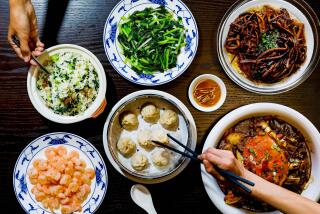Harbin: A Place to Avoid in the Winter
- Share via
HARBIN, CHINA — The waitress in Harbin’s “famous” Beilaishun restaurant wanted 42 yuan ($15) for a Mongolian hot pot for two.
It was an outrageously high price for a meal, more than twice what one would pay in a less shabby eatery in Peking. The foreign visitors objected.
“OK,” she said, “how much do you want to pay?”
After several minutes’ discussion, they settled on 20 yuan ($7) for two and sat down. Soon the hungry tourists were tending a blackened copper pot fired by charcoal.
On the face of it, this restaurant in China’s northeast province of Heilongjiang was a most revolting place to eat. Shadowy lighting helped mask a dingy room, filthy wooden tables, broken chairs, and a floor strewn with dark clumps of crab shell, broken bottles, and stray chopsticks.
But in view of the circumstances, the setting could be overlooked. The outside temperature was around zero degrees F. (a mild night by local standards) and it was after 7:30 p.m., when most Chinese restaurants are closed.
The last 20 or so patrons -- rugged-looking men and women with dark and weathered faces -- sat at nearby tables eating and drinking in their bulky overcoats. The local people were friendly but dignified. After a few honest stares and comradely nods, they returned to their private conversations and ignored the strangers in their midst. After all, this was Manchuria -- where Russians, Japanese, Koreans, Manchus, Mongols, and Han Chinese had mingled for many generations.
If China guidebook writers have been to Harbin at all,they usually advise travelers to avoid it in winter.
The average January temperature is 5 degrees F. and frequently plummets to -22 degrees F. or below. The February average checks in at -13 degrees F.
Local residents enjoy being out of doors during the frigid, gray months. Harbin’s streets and many parks are bustling in January and February, and the unheated public trams can pass by full even late at night.
Each winter day, a few hearty souls take an early morning or noon swim in a 25-meter pool cut out of the three-foot thick river ice. The coldest days bring out more swimmers, since they most enjoy the relative warmth of the river water when the air temperature is very low. At least so goes the lore of this inexplicable sport.
One of the most charming areas of this industrial city of 2.5 million people is Zhongyan Street leading from Stalin Park on the edge of the Songhua River through the old Russian district. Here sidewalk stands sell fruit, vegetables, and sweets throughout the winter. There are stands selling candied crab apples and mandarin orange sections, skewered on a wooden stick -- a popular winter snack throughout eastern China. Also on sale are brown splinters of molasses candy and rock-hard, frozen tomatoes and tangerines from the south.
Shops and restaurants along this cobblestone avenue stay open past 7 p.m., late for most Chinese cities, and crowds form at bus stops and ice-cream stands despite the bitter cold. Harbiners eat ice cream year-round, perhaps because of their Russian-dominated past.
If Harbiners don’t spend their evenings dancing at one of the hotels, they may go to the ice lantern festival in January and February. This annual exhibition fills Zhaolin Park with sculptures of animals and humans and almost full-scale models of pavilions, bridges, a pagoda, and other monuments. Thousands of adults and children slide down the ice chutes and record the fanciful backdrops in poses for the family photo album.
In the days of czars, emperors, and strategic railway links, Russia and Japan struggled to control the natural resources and transport routes of northeastern China.
The Russians dominated here in China’s northern-most territory, and beginning in the late 1890s, Harbin was transformed from a Manchu fishing village into a Russian city. For visitors today, it is this Russian past that gives Harbin its character.
By the 1920s, Harbin’s Russian emigre population had grown to several hundred thousand, many of whom were living a genteel life no longer possible in their now-communist homeland. Harbin’s hotels, shops, and restaurants catered to the cultivated tastes of the White Russian exiles as well as to thousands of Soviet and East European Jews.
Dozens of onion-domed Russian Orthodox churches dotted the city, and there were a few synagogues, mosques, and Christian churches. It was here that the Scottish missionary, Eric Liddell -- whose career as an Olympic runner in 1924 was popularized in the movie “Chariots of Fire” -- preached sermons for almost two decades.
Despite its hardships, the period of the Japanese annexation of Manchuria (1931 to 1945) benefited the region with the construction of heavy industry. After the Communist victory in 1949, the Chinese were beholden to Moscow’s assistance in rebuilding the industries the Soviet Red Army had pillaged only a few years before. During the heyday of Sino-Soviet friendship in the 1950s, Harbin was thick with Soviet advisers and the city was known as the “eastern Moscow.” During this time there were still between 20,000 and 40,000 White Russians living here.
More to Read
Sign up for The Wild
We’ll help you find the best places to hike, bike and run, as well as the perfect silent spots for meditation and yoga.
You may occasionally receive promotional content from the Los Angeles Times.






